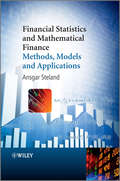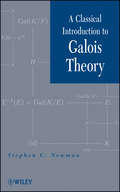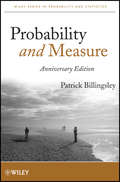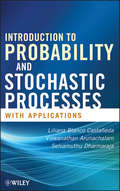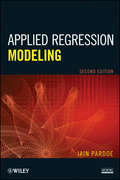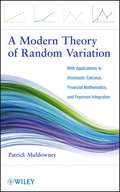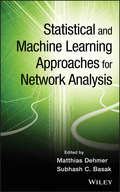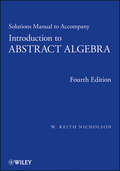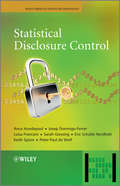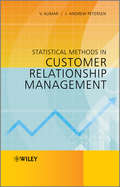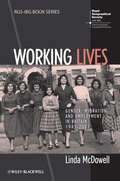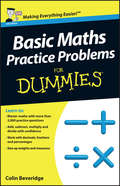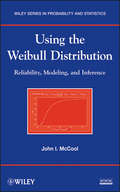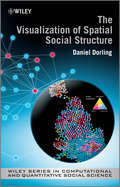- Table View
- List View
Financial Statistics and Mathematical Finance: Methods, Models and Applications
by Ansgar StelandMathematical finance has grown into a huge area of research which requires a lot of care and a large number of sophisticated mathematical tools. Mathematically rigorous and yet accessible to advanced level practitioners and mathematicians alike, it considers various aspects of the application of statistical methods in finance and illustrates some of the many ways that statistical tools are used in financial applications. Financial Statistics and Mathematical Finance: Provides an introduction to the basics of financial statistics and mathematical finance. Explains the use and importance of statistical methods in econometrics and financial engineering. Illustrates the importance of derivatives and calculus to aid understanding in methods and results. Looks at advanced topics such as martingale theory, stochastic processes and stochastic integration. Features examples throughout to illustrate applications in mathematical and statistical finance. Is supported by an accompanying website featuring R code and data sets. Financial Statistics and Mathematical Finance introduces the financial methodology and the relevant mathematical tools in a style that is both mathematically rigorous and yet accessible to advanced level practitioners and mathematicians alike, both graduate students and researchers in statistics, finance, econometrics and business administration will benefit from this book.
Financial Statistics and Mathematical Finance: Methods, Models and Applications
by Ansgar StelandMathematical finance has grown into a huge area of research which requires a lot of care and a large number of sophisticated mathematical tools. Mathematically rigorous and yet accessible to advanced level practitioners and mathematicians alike, it considers various aspects of the application of statistical methods in finance and illustrates some of the many ways that statistical tools are used in financial applications. Financial Statistics and Mathematical Finance: Provides an introduction to the basics of financial statistics and mathematical finance. Explains the use and importance of statistical methods in econometrics and financial engineering. Illustrates the importance of derivatives and calculus to aid understanding in methods and results. Looks at advanced topics such as martingale theory, stochastic processes and stochastic integration. Features examples throughout to illustrate applications in mathematical and statistical finance. Is supported by an accompanying website featuring R code and data sets. Financial Statistics and Mathematical Finance introduces the financial methodology and the relevant mathematical tools in a style that is both mathematically rigorous and yet accessible to advanced level practitioners and mathematicians alike, both graduate students and researchers in statistics, finance, econometrics and business administration will benefit from this book.
A Classical Introduction to Galois Theory
by Stephen C. NewmanExplore the foundations and modern applications of Galois theory Galois theory is widely regarded as one of the most elegant areas of mathematics. A Classical Introduction to Galois Theory develops the topic from a historical perspective, with an emphasis on the solvability of polynomials by radicals. The book provides a gradual transition from the computational methods typical of early literature on the subject to the more abstract approach that characterizes most contemporary expositions. The author provides an easily-accessible presentation of fundamental notions such as roots of unity, minimal polynomials, primitive elements, radical extensions, fixed fields, groups of automorphisms, and solvable series. As a result, their role in modern treatments of Galois theory is clearly illuminated for readers. Classical theorems by Abel, Galois, Gauss, Kronecker, Lagrange, and Ruffini are presented, and the power of Galois theory as both a theoretical and computational tool is illustrated through: A study of the solvability of polynomials of prime degree Development of the theory of periods of roots of unity Derivation of the classical formulas for solving general quadratic, cubic, and quartic polynomials by radicals Throughout the book, key theorems are proved in two ways, once using a classical approach and then again utilizing modern methods. Numerous worked examples showcase the discussed techniques, and background material on groups and fields is provided, supplying readers with a self-contained discussion of the topic. A Classical Introduction to Galois Theory is an excellent resource for courses on abstract algebra at the upper-undergraduate level. The book is also appealing to anyone interested in understanding the origins of Galois theory, why it was created, and how it has evolved into the discipline it is today.
A Classical Introduction to Galois Theory
by Stephen C. NewmanExplore the foundations and modern applications of Galois theory Galois theory is widely regarded as one of the most elegant areas of mathematics. A Classical Introduction to Galois Theory develops the topic from a historical perspective, with an emphasis on the solvability of polynomials by radicals. The book provides a gradual transition from the computational methods typical of early literature on the subject to the more abstract approach that characterizes most contemporary expositions. The author provides an easily-accessible presentation of fundamental notions such as roots of unity, minimal polynomials, primitive elements, radical extensions, fixed fields, groups of automorphisms, and solvable series. As a result, their role in modern treatments of Galois theory is clearly illuminated for readers. Classical theorems by Abel, Galois, Gauss, Kronecker, Lagrange, and Ruffini are presented, and the power of Galois theory as both a theoretical and computational tool is illustrated through: A study of the solvability of polynomials of prime degree Development of the theory of periods of roots of unity Derivation of the classical formulas for solving general quadratic, cubic, and quartic polynomials by radicals Throughout the book, key theorems are proved in two ways, once using a classical approach and then again utilizing modern methods. Numerous worked examples showcase the discussed techniques, and background material on groups and fields is provided, supplying readers with a self-contained discussion of the topic. A Classical Introduction to Galois Theory is an excellent resource for courses on abstract algebra at the upper-undergraduate level. The book is also appealing to anyone interested in understanding the origins of Galois theory, why it was created, and how it has evolved into the discipline it is today.
Probability and Measure (Wiley Series in Probability and Statistics #939)
by Patrick BillingsleyPraise for the Third Edition "It is, as far as I'm concerned, among the best books in math ever written....if you are a mathematician and want to have the top reference in probability, this is it." (Amazon.com, January 2006) A complete and comprehensive classic in probability and measure theory Probability and Measure, Anniversary Edition by Patrick Billingsley celebrates the achievements and advancements that have made this book a classic in its field for the past 35 years. Now re-issued in a new style and format, but with the reliable content that the third edition was revered for, this Anniversary Edition builds on its strong foundation of measure theory and probability with Billingsley's unique writing style. In recognition of 35 years of publication, impacting tens of thousands of readers, this Anniversary Edition has been completely redesigned in a new, open and user-friendly way in order to appeal to university-level students. This book adds a new foreward by Steve Lally of the Statistics Department at The University of Chicago in order to underscore the many years of successful publication and world-wide popularity and emphasize the educational value of this book. The Anniversary Edition contains features including: An improved treatment of Brownian motion Replacement of queuing theory with ergodic theory Theory and applications used to illustrate real-life situations Over 300 problems with corresponding, intensive notes and solutions Updated bibliography An extensive supplement of additional notes on the problems and chapter commentaries Patrick Billingsley was a first-class, world-renowned authority in probability and measure theory at a leading U.S. institution of higher education. He continued to be an influential probability theorist until his unfortunate death in 2011. Billingsley earned his Bachelor's Degree in Engineering from the U.S. Naval Academy where he served as an officer. he went on to receive his Master's Degree and doctorate in Mathematics from Princeton University.Among his many professional awards was the Mathematical Association of America's Lester R. Ford Award for mathematical exposition. His achievements through his long and esteemed career have solidified Patrick Billingsley's place as a leading authority in the field and been a large reason for his books being regarded as classics. This Anniversary Edition of Probability and Measure offers advanced students, scientists, and engineers an integrated introduction to measure theory and probability. Like the previous editions, this Anniversary Edition is a key resource for students of mathematics, statistics, economics, and a wide variety of disciplines that require a solid understanding of probability theory.
Introduction to Probability and Stochastic Processes with Applications
by Liliana Blanco Castañeda Viswanathan Arunachalam Selvamuthu DharmarajaAn easily accessible, real-world approach to probability and stochastic processes Introduction to Probability and Stochastic Processes with Applications presents a clear, easy-to-understand treatment of probability and stochastic processes, providing readers with a solid foundation they can build upon throughout their careers. With an emphasis on applications in engineering, applied sciences, business and finance, statistics, mathematics, and operations research, the book features numerous real-world examples that illustrate how random phenomena occur in nature and how to use probabilistic techniques to accurately model these phenomena. The authors discuss a broad range of topics, from the basic concepts of probability to advanced topics for further study, including Itô integrals, martingales, and sigma algebras. Additional topical coverage includes: Distributions of discrete and continuous random variables frequently used in applications Random vectors, conditional probability, expectation, and multivariate normal distributions The laws of large numbers, limit theorems, and convergence of sequences of random variables Stochastic processes and related applications, particularly in queueing systems Financial mathematics, including pricing methods such as risk-neutral valuation and the Black-Scholes formula Extensive appendices containing a review of the requisite mathematics and tables of standard distributions for use in applications are provided, and plentiful exercises, problems, and solutions are found throughout. Also, a related website features additional exercises with solutions and supplementary material for classroom use. Introduction to Probability and Stochastic Processes with Applications is an ideal book for probability courses at the upper-undergraduate level. The book is also a valuable reference for researchers and practitioners in the fields of engineering, operations research, and computer science who conduct data analysis to make decisions in their everyday work.
Applied Regression Modeling
by Iain PardoePraise for the First Edition "The attention to detail is impressive. The book is very well written and the author is extremely careful with his descriptions . . . the examples are wonderful." —The American Statistician Fully revised to reflect the latest methodologies and emerging applications, Applied Regression Modeling, Second Edition continues to highlight the benefits of statistical methods, specifically regression analysis and modeling, for understanding, analyzing, and interpreting multivariate data in business, science, and social science applications. The author utilizes a bounty of real-life examples, case studies, illustrations, and graphics to introduce readers to the world of regression analysis using various software packages, including R, SPSS, Minitab, SAS, JMP, and S-PLUS. In a clear and careful writing style, the book introduces modeling extensions that illustrate more advanced regression techniques, including logistic regression, Poisson regression, discrete choice models, multilevel models, and Bayesian modeling. In addition, the Second Edition features clarification and expansion of challenging topics, such as: Transformations, indicator variables, and interaction Testing model assumptions Nonconstant variance Autocorrelation Variable selection methods Model building and graphical interpretation Throughout the book, datasets and examples have been updated and additional problems are included at the end of each chapter, allowing readers to test their comprehension of the presented material. In addition, a related website features the book's datasets, presentation slides, detailed statistical software instructions, and learning resources including additional problems and instructional videos. With an intuitive approach that is not heavy on mathematical detail, Applied Regression Modeling, Second Edition is an excellent book for courses on statistical regression analysis at the upper-undergraduate and graduate level. The book also serves as a valuable resource for professionals and researchers who utilize statistical methods for decision-making in their everyday work.
Applied Regression Modeling: A Business Approach
by Iain PardoePraise for the First Edition "The attention to detail is impressive. The book is very well written and the author is extremely careful with his descriptions . . . the examples are wonderful." —The American Statistician Fully revised to reflect the latest methodologies and emerging applications, Applied Regression Modeling, Second Edition continues to highlight the benefits of statistical methods, specifically regression analysis and modeling, for understanding, analyzing, and interpreting multivariate data in business, science, and social science applications. The author utilizes a bounty of real-life examples, case studies, illustrations, and graphics to introduce readers to the world of regression analysis using various software packages, including R, SPSS, Minitab, SAS, JMP, and S-PLUS. In a clear and careful writing style, the book introduces modeling extensions that illustrate more advanced regression techniques, including logistic regression, Poisson regression, discrete choice models, multilevel models, and Bayesian modeling. In addition, the Second Edition features clarification and expansion of challenging topics, such as: Transformations, indicator variables, and interaction Testing model assumptions Nonconstant variance Autocorrelation Variable selection methods Model building and graphical interpretation Throughout the book, datasets and examples have been updated and additional problems are included at the end of each chapter, allowing readers to test their comprehension of the presented material. In addition, a related website features the book's datasets, presentation slides, detailed statistical software instructions, and learning resources including additional problems and instructional videos. With an intuitive approach that is not heavy on mathematical detail, Applied Regression Modeling, Second Edition is an excellent book for courses on statistical regression analysis at the upper-undergraduate and graduate level. The book also serves as a valuable resource for professionals and researchers who utilize statistical methods for decision-making in their everyday work.
A Modern Theory of Random Variation: With Applications in Stochastic Calculus, Financial Mathematics, and Feynman Integration
by Patrick MuldowneyA ground-breaking and practical treatment of probability and stochastic processes A Modern Theory of Random Variation is a new and radical re-formulation of the mathematical underpinnings of subjects as diverse as investment, communication engineering, and quantum mechanics. Setting aside the classical theory of probability measure spaces, the book utilizes a mathematically rigorous version of the theory of random variation that bases itself exclusively on finitely additive probability distribution functions. In place of twentieth century Lebesgue integration and measure theory, the author uses the simpler concept of Riemann sums, and the non-absolute Riemann-type integration of Henstock. Readers are supplied with an accessible approach to standard elements of probability theory such as the central limmit theorem and Brownian motion as well as remarkable, new results on Feynman diagrams and stochastic integrals. Throughout the book, detailed numerical demonstrations accompany the discussions of abstract mathematical theory, from the simplest elements of the subject to the most complex. In addition, an array of numerical examples and vivid illustrations showcase how the presented methods and applications can be undertaken at various levels of complexity. A Modern Theory of Random Variation is a suitable book for courses on mathematical analysis, probability theory, and mathematical finance at the upper-undergraduate and graduate levels. The book is also an indispensible resource for researchers and practitioners who are seeking new concepts, techniques and methodologies in data analysis, numerical calculation, and financial asset valuation. Patrick Muldowney, PhD, served as lecturer at the Magee Business School of the UNiversity of Ulster for over twenty years. Dr. Muldowney has published extensively in his areas of research, including integration theory, financial mathematics, and random variation.
A Modern Theory of Random Variation: With Applications in Stochastic Calculus, Financial Mathematics, and Feynman Integration
by Patrick MuldowneyA ground-breaking and practical treatment of probability and stochastic processes A Modern Theory of Random Variation is a new and radical re-formulation of the mathematical underpinnings of subjects as diverse as investment, communication engineering, and quantum mechanics. Setting aside the classical theory of probability measure spaces, the book utilizes a mathematically rigorous version of the theory of random variation that bases itself exclusively on finitely additive probability distribution functions. In place of twentieth century Lebesgue integration and measure theory, the author uses the simpler concept of Riemann sums, and the non-absolute Riemann-type integration of Henstock. Readers are supplied with an accessible approach to standard elements of probability theory such as the central limmit theorem and Brownian motion as well as remarkable, new results on Feynman diagrams and stochastic integrals. Throughout the book, detailed numerical demonstrations accompany the discussions of abstract mathematical theory, from the simplest elements of the subject to the most complex. In addition, an array of numerical examples and vivid illustrations showcase how the presented methods and applications can be undertaken at various levels of complexity. A Modern Theory of Random Variation is a suitable book for courses on mathematical analysis, probability theory, and mathematical finance at the upper-undergraduate and graduate levels. The book is also an indispensible resource for researchers and practitioners who are seeking new concepts, techniques and methodologies in data analysis, numerical calculation, and financial asset valuation. Patrick Muldowney, PhD, served as lecturer at the Magee Business School of the UNiversity of Ulster for over twenty years. Dr. Muldowney has published extensively in his areas of research, including integration theory, financial mathematics, and random variation.
Statistical and Machine Learning Approaches for Network Analysis (Wiley Series in Computational Statistics #707)
by Matthias Dehmer Subhash C. BasakExplore the multidisciplinary nature of complex networks through machine learning techniques Statistical and Machine Learning Approaches for Network Analysis provides an accessible framework for structurally analyzing graphs by bringing together known and novel approaches on graph classes and graph measures for classification. By providing different approaches based on experimental data, the book uniquely sets itself apart from the current literature by exploring the application of machine learning techniques to various types of complex networks. Comprised of chapters written by internationally renowned researchers in the field of interdisciplinary network theory, the book presents current and classical methods to analyze networks statistically. Methods from machine learning, data mining, and information theory are strongly emphasized throughout. Real data sets are used to showcase the discussed methods and topics, which include: A survey of computational approaches to reconstruct and partition biological networks An introduction to complex networks—measures, statistical properties, and models Modeling for evolving biological networks The structure of an evolving random bipartite graph Density-based enumeration in structured data Hyponym extraction employing a weighted graph kernel Statistical and Machine Learning Approaches for Network Analysis is an excellent supplemental text for graduate-level, cross-disciplinary courses in applied discrete mathematics, bioinformatics, pattern recognition, and computer science. The book is also a valuable reference for researchers and practitioners in the fields of applied discrete mathematics, machine learning, data mining, and biostatistics.
Statistical and Machine Learning Approaches for Network Analysis (Wiley Series in Computational Statistics #707)
by Matthias Dehmer Subhash C. BasakExplore the multidisciplinary nature of complex networks through machine learning techniques Statistical and Machine Learning Approaches for Network Analysis provides an accessible framework for structurally analyzing graphs by bringing together known and novel approaches on graph classes and graph measures for classification. By providing different approaches based on experimental data, the book uniquely sets itself apart from the current literature by exploring the application of machine learning techniques to various types of complex networks. Comprised of chapters written by internationally renowned researchers in the field of interdisciplinary network theory, the book presents current and classical methods to analyze networks statistically. Methods from machine learning, data mining, and information theory are strongly emphasized throughout. Real data sets are used to showcase the discussed methods and topics, which include: A survey of computational approaches to reconstruct and partition biological networks An introduction to complex networks—measures, statistical properties, and models Modeling for evolving biological networks The structure of an evolving random bipartite graph Density-based enumeration in structured data Hyponym extraction employing a weighted graph kernel Statistical and Machine Learning Approaches for Network Analysis is an excellent supplemental text for graduate-level, cross-disciplinary courses in applied discrete mathematics, bioinformatics, pattern recognition, and computer science. The book is also a valuable reference for researchers and practitioners in the fields of applied discrete mathematics, machine learning, data mining, and biostatistics.
Solutions Manual to accompany Introduction to Abstract Algebra, 4e, Solutions Manual
by W. Keith NicholsonAn indispensable companion to the book hailed an "expository masterpiece of the highest didactic value" by Zentralblatt MATH This solutions manual helps readers test and reinforce the understanding of the principles and real-world applications of abstract algebra gained from their reading of the critically acclaimed Introduction to Abstract Algebra. Ideal for students, as well as engineers, computer scientists, and applied mathematicians interested in the subject, it provides a wealth of concrete examples of induction, number theory, integers modulo n, and permutations. Worked examples and real-world problems help ensure a complete understanding of the subject, regardless of a reader's background in mathematics.
Solutions Manual to accompany Introduction to Abstract Algebra, 4e, Solutions Manual
by W. Keith NicholsonAn indispensable companion to the book hailed an "expository masterpiece of the highest didactic value" by Zentralblatt MATH This solutions manual helps readers test and reinforce the understanding of the principles and real-world applications of abstract algebra gained from their reading of the critically acclaimed Introduction to Abstract Algebra. Ideal for students, as well as engineers, computer scientists, and applied mathematicians interested in the subject, it provides a wealth of concrete examples of induction, number theory, integers modulo n, and permutations. Worked examples and real-world problems help ensure a complete understanding of the subject, regardless of a reader's background in mathematics.
Statistical Disclosure Control (Wiley Series in Survey Methodology)
by Anco Hundepool Josep Domingo-Ferrer Luisa Franconi Sarah Giessing Eric Schulte Nordholt Keith Spicer Peter-Paul de WolfA reference to answer all your statistical confidentiality questions. This handbook provides technical guidance on statistical disclosure control and on how to approach the problem of balancing the need to provide users with statistical outputs and the need to protect the confidentiality of respondents. Statistical disclosure control is combined with other tools such as administrative, legal and IT in order to define a proper data dissemination strategy based on a risk management approach. The key concepts of statistical disclosure control are presented, along with the methodology and software that can be used to apply various methods of statistical disclosure control. Numerous examples and guidelines are also featured to illustrate the topics covered. Statistical Disclosure Control: Presents a combination of both theoretical and practical solutions Introduces all the key concepts and definitions involved with statistical disclosure control. Provides a high level overview of how to approach problems associated with confidentiality. Provides a broad-ranging review of the methods available to control disclosure. Explains the subtleties of group disclosure control. Features examples throughout the book along with case studies demonstrating how particular methods are used. Discusses microdata, magnitude and frequency tabular data, and remote access issues. Written by experts within leading National Statistical Institutes. Official statisticians, academics and market researchers who need to be informed and make decisions on disclosure limitation will benefit from this book.
Statistical Disclosure Control (Wiley Series in Survey Methodology)
by Anco Hundepool Josep Domingo-Ferrer Luisa Franconi Sarah Giessing Eric Schulte Nordholt Keith Spicer Peter-Paul de WolfA reference to answer all your statistical confidentiality questions. This handbook provides technical guidance on statistical disclosure control and on how to approach the problem of balancing the need to provide users with statistical outputs and the need to protect the confidentiality of respondents. Statistical disclosure control is combined with other tools such as administrative, legal and IT in order to define a proper data dissemination strategy based on a risk management approach. The key concepts of statistical disclosure control are presented, along with the methodology and software that can be used to apply various methods of statistical disclosure control. Numerous examples and guidelines are also featured to illustrate the topics covered. Statistical Disclosure Control: Presents a combination of both theoretical and practical solutions Introduces all the key concepts and definitions involved with statistical disclosure control. Provides a high level overview of how to approach problems associated with confidentiality. Provides a broad-ranging review of the methods available to control disclosure. Explains the subtleties of group disclosure control. Features examples throughout the book along with case studies demonstrating how particular methods are used. Discusses microdata, magnitude and frequency tabular data, and remote access issues. Written by experts within leading National Statistical Institutes. Official statisticians, academics and market researchers who need to be informed and make decisions on disclosure limitation will benefit from this book.
Statistical Methods in Customer Relationship Management
by V. Kumar J. Andrew PetersenStatistical Methods in Customer Relationship Management focuses on the quantitative and modeling aspects of customer management strategies that lead to future firm profitability, with emphasis on developing an understanding of Customer Relationship Management (CRM) models as the guiding concept for profitable customer management. To understand and explore the functioning of CRM models, this book traces the management strategies throughout a customer’s tenure with a firm. Furthermore, the book explores in detail CRM models for customer acquisition, customer retention, customer acquisition and retention, customer churn, and customer win back. Statistical Methods in Customer Relationship Management: Provides an overview of a CRM system, introducing key concepts and metrics needed to understand and implement these models. Focuses on five CRM models: customer acquisition, customer retention, customer churn, and customer win back with supporting case studies. Explores each model in detail, from investigating the need for CRM models to looking at the future of the models. Presents models and concepts that span across the introductory, advanced, and specialist levels. Academics and practitioners involved in the area of CRM as well as instructors of applied statistics and quantitative marketing courses will benefit from this book.
Statistical Methods in Customer Relationship Management
by V. Kumar J. Andrew PetersenStatistical Methods in Customer Relationship Management focuses on the quantitative and modeling aspects of customer management strategies that lead to future firm profitability, with emphasis on developing an understanding of Customer Relationship Management (CRM) models as the guiding concept for profitable customer management. To understand and explore the functioning of CRM models, this book traces the management strategies throughout a customer’s tenure with a firm. Furthermore, the book explores in detail CRM models for customer acquisition, customer retention, customer acquisition and retention, customer churn, and customer win back. Statistical Methods in Customer Relationship Management: Provides an overview of a CRM system, introducing key concepts and metrics needed to understand and implement these models. Focuses on five CRM models: customer acquisition, customer retention, customer churn, and customer win back with supporting case studies. Explores each model in detail, from investigating the need for CRM models to looking at the future of the models. Presents models and concepts that span across the introductory, advanced, and specialist levels. Academics and practitioners involved in the area of CRM as well as instructors of applied statistics and quantitative marketing courses will benefit from this book.
Working Lives: Gender, Migration and Employment in Britain, 1945-2007 (RGS-IBG Book Series)
by Linda McDowellFull of unique and compelling insights into the working lives of migrant women in the UK, this book draws on more than two decades of in-depth research to explore the changing nature of women’s employment in post-war Britain. A first-rate example of theoretically located empirical analysis of labour market change in contemporary Britain Includes compelling case studies that combine historical documentation of social change with fascinating first-hand accounts of women’s working lives over decades Integrates information gleaned from more than two decades of in-depth research Revealing comparative analysis of the similarities and differences in the lives of immigrant working women in post-war Britain Features real-life accounts of women’s under-reported experiences of migration
Working Lives: Gender, Migration and Employment in Britain, 1945-2007 (RGS-IBG Book Series)
by Linda McDowellFull of unique and compelling insights into the working lives of migrant women in the UK, this book draws on more than two decades of in-depth research to explore the changing nature of women’s employment in post-war Britain. A first-rate example of theoretically located empirical analysis of labour market change in contemporary Britain Includes compelling case studies that combine historical documentation of social change with fascinating first-hand accounts of women’s working lives over decades Integrates information gleaned from more than two decades of in-depth research Revealing comparative analysis of the similarities and differences in the lives of immigrant working women in post-war Britain Features real-life accounts of women’s under-reported experiences of migration
Basic Maths Practice Problems For Dummies
by Colin BeveridgeLearn to: Master maths with more than 2,000 practice questions Add, subtract, multiply and divide with confidence Work with decimals, fractions and percentages Size up weights and measures Fun, friendly coaching and all the practice you need to tackle maths problems with confidence and ease In his popular Basic Maths For Dummies, professional maths tutor Colin Beveridge proved that he could turn anyone – even the most maths-phobic person – into a natural-born number cruncher. In this book he supplies more of his unique brand of maths-made-easy coaching, plus 2,000 practice problems to help you master what you learn. Whether you're prepping for a numeracy test or an employability exam, thinking of returning to school, or you'd just like to be one of those know-it-alls who says, 'Oh, that's easy!' about any maths problem that comes your way, this book is for you. Master basic arithmetic, fast – in no time, solving addition, subtraction, multiplication and division problems will seem as easy as tying your shoes Face down fractions – you'll never again feel shy around fractions, decimals, percentages and ratios Juggle weights and measures like a pro – whether it's a question of how much it weighs, how long (or far) it is, or how much it costs, you'll never be at a loss for an answer Make shapes your playthings – circles, squares, triangles and rectangles – you'll measure them, draw them and manipulate them with ease Open the book and find: 2,000 pencil-and-paper practice problems The keys to mastering addition, subtraction, multiplication and division The lowdown on fractions, decimals and percentages Basic geometry made easy How to handle weights, measures and money problems How to read charts, tables and graphs at a glance
Basic Maths Practice Problems For Dummies
by Colin BeveridgeLearn to: Master maths with more than 2,000 practice questions Add, subtract, multiply and divide with confidence Work with decimals, fractions and percentages Size up weights and measures Fun, friendly coaching and all the practice you need to tackle maths problems with confidence and ease In his popular Basic Maths For Dummies, professional maths tutor Colin Beveridge proved that he could turn anyone – even the most maths-phobic person – into a natural-born number cruncher. In this book he supplies more of his unique brand of maths-made-easy coaching, plus 2,000 practice problems to help you master what you learn. Whether you're prepping for a numeracy test or an employability exam, thinking of returning to school, or you'd just like to be one of those know-it-alls who says, 'Oh, that's easy!' about any maths problem that comes your way, this book is for you. Master basic arithmetic, fast – in no time, solving addition, subtraction, multiplication and division problems will seem as easy as tying your shoes Face down fractions – you'll never again feel shy around fractions, decimals, percentages and ratios Juggle weights and measures like a pro – whether it's a question of how much it weighs, how long (or far) it is, or how much it costs, you'll never be at a loss for an answer Make shapes your playthings – circles, squares, triangles and rectangles – you'll measure them, draw them and manipulate them with ease Open the book and find: 2,000 pencil-and-paper practice problems The keys to mastering addition, subtraction, multiplication and division The lowdown on fractions, decimals and percentages Basic geometry made easy How to handle weights, measures and money problems How to read charts, tables and graphs at a glance
Using the Weibull Distribution: Reliability, Modeling, and Inference (Wiley Series in Probability and Statistics #950)
by John I. McCoolUnderstand and utilize the latest developments in Weibull inferential methods While the Weibull distribution is widely used in science and engineering, most engineers do not have the necessary statistical training to implement the methodology effectively. Using the Weibull Distribution: Reliability, Modeling, and Inference fills a gap in the current literature on the topic, introducing a self-contained presentation of the probabilistic basis for the methodology while providing powerful techniques for extracting information from data. The author explains the use of the Weibull distribution and its statistical and probabilistic basis, providing a wealth of material that is not available in the current literature. The book begins by outlining the fundamental probability and statistical concepts that serve as a foundation for subsequent topics of coverage, including: • Optimum burn-in, age and block replacement, warranties and renewal theory • Exact inference in Weibull regression • Goodness of fit testing and distinguishing the Weibull from the lognormal • Inference for the Three Parameter Weibull Throughout the book, a wealth of real-world examples showcases the discussed topics and each chapter concludes with a set of exercises, allowing readers to test their understanding of the presented material. In addition, a related website features the author's own software for implementing the discussed analyses along with a set of modules written in Mathcad®, and additional graphical interface software for performing simulations. With its numerous hands-on examples, exercises, and software applications, Using the Weibull Distribution is an excellent book for courses on quality control and reliability engineering at the upper-undergraduate and graduate levels. The book also serves as a valuable reference for engineers, scientists, and business analysts who gather and interpret data that follows the Weibull distribution
Using the Weibull Distribution: Reliability, Modeling, and Inference (Wiley Series in Probability and Statistics #950)
by John I. McCoolUnderstand and utilize the latest developments in Weibull inferential methods While the Weibull distribution is widely used in science and engineering, most engineers do not have the necessary statistical training to implement the methodology effectively. Using the Weibull Distribution: Reliability, Modeling, and Inference fills a gap in the current literature on the topic, introducing a self-contained presentation of the probabilistic basis for the methodology while providing powerful techniques for extracting information from data. The author explains the use of the Weibull distribution and its statistical and probabilistic basis, providing a wealth of material that is not available in the current literature. The book begins by outlining the fundamental probability and statistical concepts that serve as a foundation for subsequent topics of coverage, including: • Optimum burn-in, age and block replacement, warranties and renewal theory • Exact inference in Weibull regression • Goodness of fit testing and distinguishing the Weibull from the lognormal • Inference for the Three Parameter Weibull Throughout the book, a wealth of real-world examples showcases the discussed topics and each chapter concludes with a set of exercises, allowing readers to test their understanding of the presented material. In addition, a related website features the author's own software for implementing the discussed analyses along with a set of modules written in Mathcad®, and additional graphical interface software for performing simulations. With its numerous hands-on examples, exercises, and software applications, Using the Weibull Distribution is an excellent book for courses on quality control and reliability engineering at the upper-undergraduate and graduate levels. The book also serves as a valuable reference for engineers, scientists, and business analysts who gather and interpret data that follows the Weibull distribution
The Visualization of Spatial Social Structure (Wiley Series in Computational and Quantitative Social Science)
by Danny DorlingHow do you draw a map of 100,000 places, of more than a million flows of people, of changes over time and space, of different kinds of spaces, surfaces and volumes, from human travel time to landscapes of hopes, fears, migration, manufacturing and mortality? How do you turn the millions of numbers concerning some of the most important moments of our lives into images that allow us to appreciate the aggregate while still remembering the detail? The visualization of spatial social structure means, literally, making visible the geographical patterns to the way our lives have come to be socially organised, seeing the geography in society. To a statistical readership visualization implies using data. More widely defined it implies freeing our imaginations. The Visualization of Spatial Social Structure introduces the reader to new ways of thinking about how to look at social statistics, particularly those about people in places. The author presents a unique combination of statistical focus and understanding of social structures and innovations in visualization, describing the rationale for, and development of, a new way of visualizing information in geographical research. These methods are illustrated through extensive full colour graphics; revealing mistakes, techniques and discoveries which present a picture of a changing political and social geography. More complex aspects on the surface of social landscapes are revealed with sculptured symbols allowing us to see the relationships between the wood and the trees of social structure. Today's software can be so flexible that these techniques can now be emulated without coding. This book centres on a particular place and time; 1980s Britain, and a particular set of records; routine social statistics. A great deal of information about the 80s' social geography of Britain is contained within databases such as the population censuses, surveys and administrative data. Following the release of the 2011 census, now is a good time to look back at the past to introduce many new visualization techniques that could be used by future researchers.
